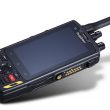Motorola launches PDA
Motorola launched the MC35 enterprise digital assistant, or EDA, in March at CTIA Wireless 2007 in Orlando. The device provides all of the voice and high-speed data capabilities typical of personal digital assistants, or PDAs, but also offers a rugged form factor and control capabilities that make it well-suited for the enterprise sector, said Mark Chellis, director of product marketing for the company’s mobile computing division.
According to Chellis, the device was put through rigorous testing before its launch. In addition to the standard 3-foot drop to a hard surface, the MC35 was tossed into a device Chellis described as a “medieval clothes dryer.”
“We literally beat the daylights out of it to see if it would still work,” he said.
The MC35’s keyboard also was tested for its ruggedness and reliability and is rated to 500,000 actuations — instances where a key is depressed — according to Chellis. In addition, the device offers an operating range of 32° to 104° Fahrenheit, though it can operate outside that range, Chellis said.
“The MC35 is quite unique,” Chellis said. “I don’t know of anyone in this class who has tried this level of ruggedness and reliability.”
The device also offers control features that typically are not found in consumer-level PDAs, according to Chellis. For instance, the built-in mobile software platform lets enterprise IT managers push out applications to everyone in the organization as needed and lock down the device when it has been reported lost or stolen.
“This is the first device in this class that’s enterprise-ready for ruggedness and manageability,” Chellis said, adding that the device will be targeted to the “blue collar/gray collar” sector. For instance, the device’s barcode scanning capability makes it suitable for use in warehouses, while real estate agents should find the high-resolution, 2-megapixel camera to be quite useful, Chellis said.
The strategy makes sense, according to Sean Ryan, wireless analyst for IDC.
“Essentially, they’re trying to bridge the gap between the person on the manufacturing floor who’s doing nothing but barcode scans and the person who also has management responsibility who might need access to data, as well as cell phone and Internet,” Ryan said. “It’s been somewhat of an underserved market.”
Ryan added that the device represents a good blend of Motorola’s capabilities and those of Symbol Technologies, which Motorola acquired in December 2006. “The rugged market has been Symbol’s bread and butter for years, while Motorola traditionally has been more of a cell phone company,” he said. “With the MC35, they’re meeting in the middle. No one has seen this as a sweet spot, so there’s an opportunity to move some of these gray collar workers to one device.”
The MC35 features the Windows Mobile 5.0 operating system, supports EDGE GPRS/GSM for wireless wide area network connectivity, 802.11b/g for wireless local area network connectivity, and Bluetooth Version 1.2 for wireless personal area network connectivity, and offers push-to-talk capability. It also has a 2.8-inch color screen. Four models are available, ranging from $640 to $760. The high-end model offers the camera and GPS capability.












